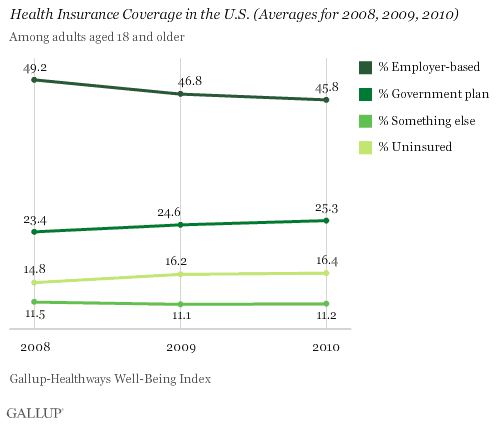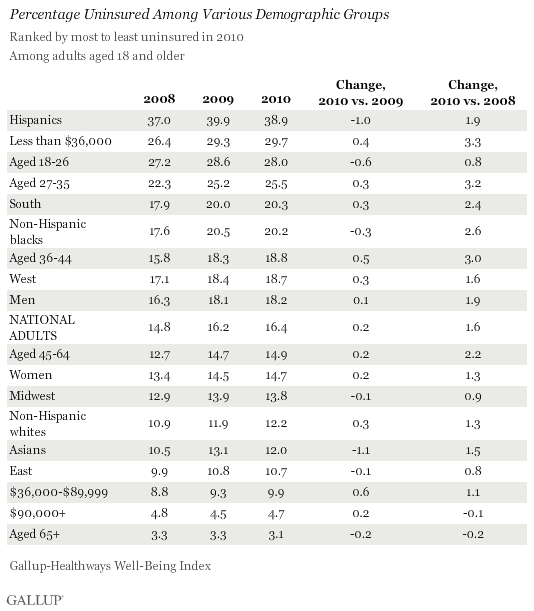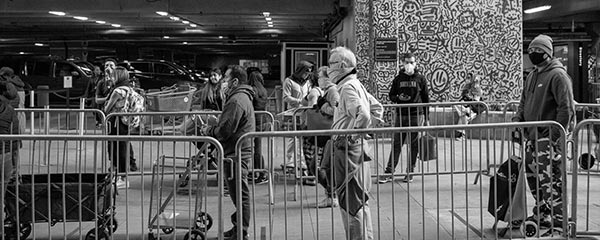WASHINGTON, D.C. -- As House Republicans prepare to vote to repeal the healthcare law President Obama signed last year, Gallup-Healthways Well-Being Index data find 16.4% of adults were uninsured in 2010, statistically unchanged from 2009, but up from 14.8% in 2008.

The percentage of American adults getting healthcare from their employer decreased to 45.8% in 2010 from 46.8% in 2009 and 49.2% in 2008. Government healthcare, on the other hand, is on the rise, with 25.3% of adults saying they got their health coverage through Medicare, Medicaid, or military/veterans' benefits, up from 24.6% in 2009, and 23.4% in 2008. The percentage of Americans who report they receive healthcare through some other means, which would include buying their own coverage, has been stable over the past three years.
The Gallup-Healthways Well-Being Index began tracking American adults' healthcare coverage in January 2008. Gallup found the monthly percentage of uninsured adults started to increase in November 2008, rising above 16% for the first time in February 2009 and remaining above that level ever since. Over the same period of time, Gallup has also tracked a steady rise in the monthly percentage of Americans who report they have government healthcare and a decline in employer-based coverage.
Hispanic, Low-Income, and Young Adult Americans Remain Most Uninsured
Hispanic Americans continue to be the most likely to be uninsured, with 38.9% going without coverage in 2010, down slightly from 39.9% in 2009, but still higher than in 2008. Nearly 3 in 10 low-income Americans were uninsured in 2010, essentially unchanged from 2009, but up significantly from 26.4% in 2008.
Young adults between the ages of 18 and 26 -- beneficiaries of a key piece of the new healthcare law that allows children up to the age of 26 to remain on their parents' plan -- are still among the most likely in the country to be uninsured at 28% in 2010. However, that is down slightly from 28.6% in 2009.

Seniors -- the group of Americans who qualify for Medicare -- and high-income Americans remain the least likely to be uninsured, with 3.1% and 4.7%, respectively, reporting no coverage in 2010.
Overall, there was little change from 2009 to 2010 in the percentage of Americans who are uninsured across socioeconomic and demographic groups; in most groups, the variation was less than one percentage point. More Americans in almost every group, however, were uninsured in 2010 than in 2008.
Bottom Line
Congressional Republicans, many of whom ran on a platform to repeal and replace -- or at least defund -- President Obama's healthcare law, are Tuesday beginning the process of attempting to deliver on that promise.
The likelihood of a full repeal is low at this point, with the Democratic-controlled Senate not likely to support the repeal and President Obama certain to veto it if they do. But, Republicans' desire to strip out or block funding for specific parts of the bill -- with their eye on the requirement that all individuals have health insurance in particular -- could have a profound effect on the healthcare law's ability to reduce the percentage of uninsured Americans.
Regardless of political or ideological viewpoints about the government's role in providing or helping to provide healthcare to all citizens, the reality in the United States is that approximately one in six adults is uninsured, leaving them potentially vulnerable and adding to the collective cost America pays for healthcare.
Survey Methods
Results are based on telephone interviews conducted as part of the Gallup-Healthways Well-Being Index survey Jan. 1-Dec. 31, 2010, with a random sample of 340,834 adults, aged 18 and older, living in all 50 U.S. states and the District of Columbia, selected using random-digit-dial sampling.
For results based on the total sample of national adults, one can say with 95% confidence that the maximum margin of sampling error is ±1 percentage point.
For results based on subgroups, one can say with 95% confidence that the maximum margin of sampling error is ±1 percentage point.
Interviews are conducted with respondents on landline telephones and cellular phones, with interviews conducted in Spanish for respondents who are primarily Spanish-speaking. Each daily sample includes a minimum quota of 200 cell phone respondents and 800 landline respondents, with additional minimum quotas among landline respondents for gender within region. Landline respondents are chosen at random within each household on the basis of which member had the most recent birthday.
Samples are weighted by gender, age, race, Hispanic ethnicity, education, region, adults in the household, cell phone-only status, cell phone-mostly status, and phone lines. Demographic weighting targets are based on the March 2010 Current Population Survey figures for the aged 18 and older non-institutionalized population living in U.S. telephone households. All reported margins of sampling error include the computed design effects for weighting and sample design.
In addition to sampling error, question wording and practical difficulties in conducting surveys can introduce error or bias into the findings of public opinion polls.
For more details on Gallup's polling methodology, visit https://www.gallup.com/.
